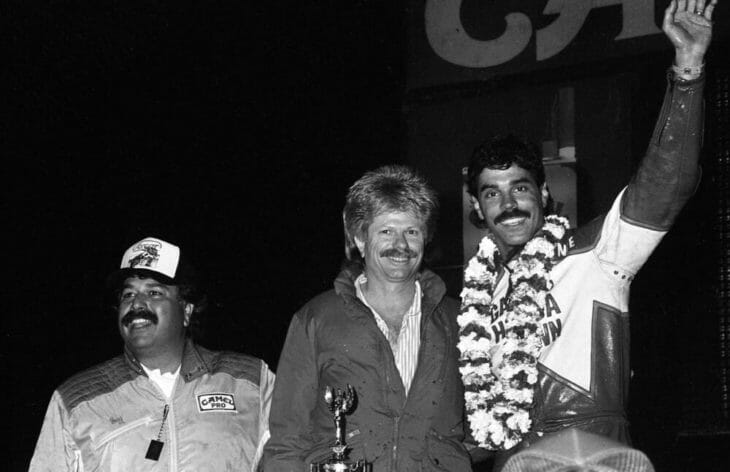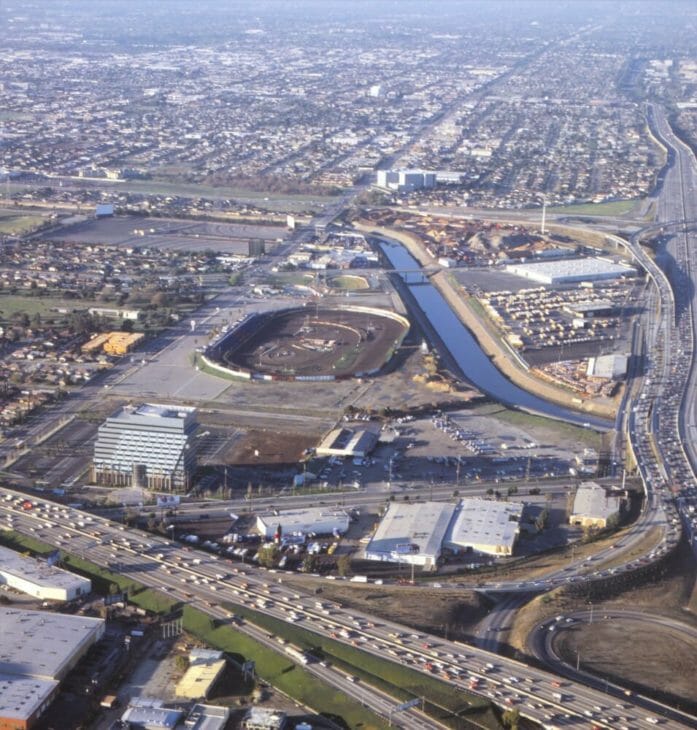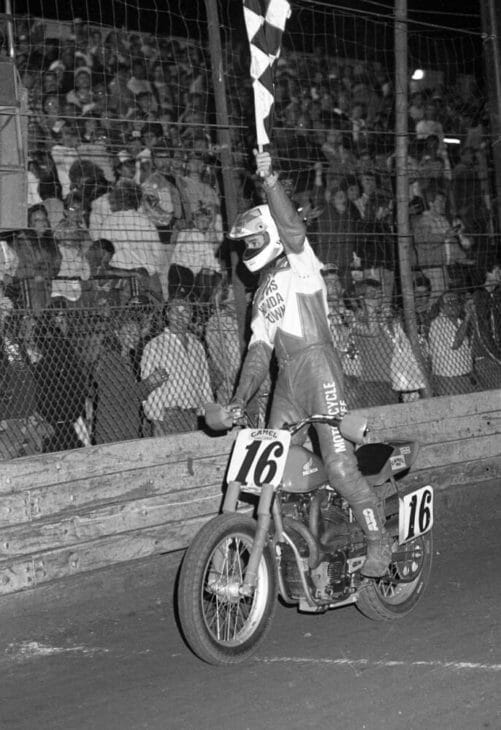Larry Lawrence | June 25, 2019
Archives: The Last Ascot
Daytona, Laguna Seca, the Springfield Mile, Peoria, Unadilla, Anaheim – all iconic racing venues for motorcycle enthusiast. Included in that group of legendary race tracks at one time was Ascot Park. The fabled dirt track venue in Gardena, California, was so popular that Honda named a motorcycle after the place. Ascot held AMA Grand Nationals (both Half-Miles and TTs) from the late 1950s to the early 1990s, but perhaps equally important was the weekly Friday night program the track held for years. On September 29, 1990, it all came to an end. Ascot held its final race. It was a sad and certainly memorable evening in Gardena. Ronnie Jones raced to victory that night in the AMA Grand National Half-Mile (appropriately enough on a Honda) and with that, the curtain closed on a track that seems destined to live on generations ahead by way of its storied history and legend.
Archives: The Last Ascot
 “Ascot Bookends” is how Gene Romero referred to Sammy Tanner (center) and Ronnie Jones (right), since Tanner won the first Ascot National in 1959 and Jones the final one in 1990. Standing on the left is Jay Agajanian whose voice could be heard across Los Angeles on the track’s frequent radio ads. (Mitch Friedman photo)
“Ascot Bookends” is how Gene Romero referred to Sammy Tanner (center) and Ronnie Jones (right), since Tanner won the first Ascot National in 1959 and Jones the final one in 1990. Standing on the left is Jay Agajanian whose voice could be heard across Los Angeles on the track’s frequent radio ads. (Mitch Friedman photo)
“You can’t say you’re a motorcycle racer until you’ve ridden Ascot. And you can’t say you’re a champion motorcycle rider until you’ve conquered it,” Kenny Roberts once told legendary LA Times motorsports reporter Shav Glick.
Over the years Ascot helped make the names of many riders who won there. Riders like Sammy Tanner, Al Gunter, Neil Keen, Eddie Mulder, Skip Van Leeuwen, Mert Lawwill, Gary Scott, Kenny Roberts, Gene Romero, Jay Springsteen, Ricky Graham, Bubba Shobert, Doug Chandler, Chris Carr, Scott Parker and many more.
Interestingly, Evel Knievel made his first nationally televised jump at Ascot.
The track was also infamous for the toll it took over the years. Among the most notable riders who passed away from crashes at Ascot are Ted Boody, who hit the wall coming out of turn four on the final lap of the national there in May of 1988; Peoria TT winner Jimmy Phillips died from a crash he had there in 1958. And then there were the lesser known racers who passed away like Steve Polson (1980), Dewayne Keeter and Tom Warren (1975), Elbert Turner (1974), Ivan Shigemasa (1973), Ted Longwith (1972), Pat Gosch (1971), Marshall Becker (1969), Steve Pederson and Don McAlear (1968), Clemmie “Stonewall” Jackson and Karl Kirschenman (1965), Bob Skibsted (1964) and Thomas Campbell (1961). Not to mention the sad and bizarre story of Travis Petton, who in 1967, crashed at Ascot and then died when the ambulance he was being transported in was involved in a head-on collision.
Experts say the tackiness of the racing surface, which made for great multi-line racing and spectacular lean angles, was the very thing that made the track so lethal. Instead of a normal low-side flat track crash, riders often got sideways, then caught traction and were flung over the high side into the unforgiving barriers that lined the outside of the oval.
“Ascot is the toughest track in the country to come in and race against the local riders,” Carroll Resweber, a four-time AMA Grand National Champion, who never could win a national race at Ascot, told Shav Glick. From 1959, when Tanner won the first national half-mile on a Triumph, until 1976, no non-California rider won against the Ascot regulars on the half-mile. In part, it was the incredible traction helped by sea air rolling into the area keeping the track surface just moist enough that it became super tacky and that gave the advantage to the West Coast riders who had ridden there and knew how to set up for that traction. It was Jay Springsteen who broke the California rider stranglehold on the Half-Mile National in 1976.
 A 1980s aerial photo of Ascot Park showing the track situated between three L.A. interstate highways. (Neil Tolhurst photo)
A 1980s aerial photo of Ascot Park showing the track situated between three L.A. interstate highways. (Neil Tolhurst photo)
The legend of the tough to beat locals (then little-known Sammy Tanner upset national champ Resweber in the first AMA National in ’59), the big crowds, the dark and gritty atmosphere, the intense racing, the spectacular crashes all combined to make Ascot Park into a nationally known venue. Angelenos were very familiar with Ascot, even if they never attended a race, thanks to radio ads that filled the L.A. airwaves always concluding with the phrase, “Come to Ascot, where the 110, the 405 and the 91 freeways collide! ”
For years Ascot hosted two nationals (a TT and Half-Mile), often one in the spring and one in the fall.
The track was built in 1957 on a former dump site and was known originally as L.A. Speedway. When new owners took it over a year later, the track was renamed Ascot Park, in honor of the historic old Legion Ascot track that had burned down in Alhambra in 1934. It was J.C. Agajanian who brought big-time racing to Ascot Park. “Aggie” formed Agajanian Enterprises with his sons, Cary, J.C. Jr. and Chris, and Ben Foote, longtime publicist and vice president. Starting in 1976 the company inked a 15-year lease on the Speedway. As the Los Angeles are exploded in growth in the 1980s, the property became too valuable. It was the same fate that many of Southern California’s racing venues met. So, before the September 1990 AMA Grand National race it was announced that it would be the final motorcycle racing event at Ascot. (The final race there was a USAC Midget race in November of ’90.)
 Ronnie Jones celebrates his victory on the Ascot Half-Mile in September of 1990 in front of a packed house of over 11,000 fans who came to witness the final motorcycle race at the famous venue. (Mitch Friedman photo)
Ronnie Jones celebrates his victory on the Ascot Half-Mile in September of 1990 in front of a packed house of over 11,000 fans who came to witness the final motorcycle race at the famous venue. (Mitch Friedman photo)
A standing room only crowd of over 11,000 showed up for the farewell national. Factory Harley rider Chris Carr was fastest in time trails and won the pole for the national with the fastest Heat race of the night. Scott Parker led the race early, but on the second lap Ronnie Jones put the Garvis Honda RS750 into the lead and simply pulled away to win the national. Carr was second, Parker third. Unfortunately, Jones never got the satisfaction of seeing the checkered flag. Will Davis crashed hard coming onto the front straight with just a few laps remaining and the race was called complete. Still Jones was pumped to take the win, his second at the track. On the podium Jones was joined by Sammy Tanner.
“Growing up I’d always heard about Ascot,” Jones said. “It wasn’t just a famous track in California, it was famous all across the country. So, when I won the last race there it was really special. They say that last national had the biggest attendance ever in the history of the track – cars or bikes. I loved racing there so much, that I was hoping against hope that they would somehow find a way to save the track. It just didn’t make sense to me that place with so much history and support was going away. It was sad in that respect.
“It was great that Sammy (Tanner) was there that night to be on the podium with me. I was at the Trailblazer’s Banquet this year. Sammy was there. Gene Romero came up to us and called us the Ascot bookends, since Sammy won the first national there and I won the last. Looking back now I’m happy I got to be a part of the track’s history.”